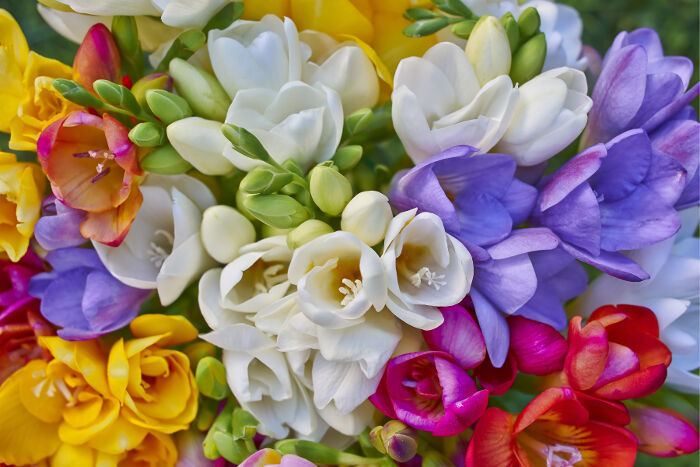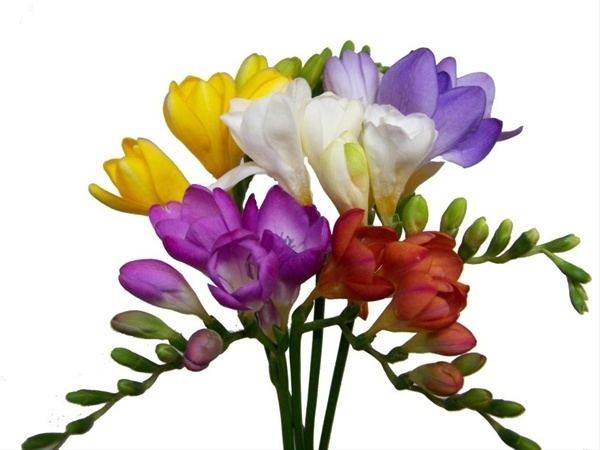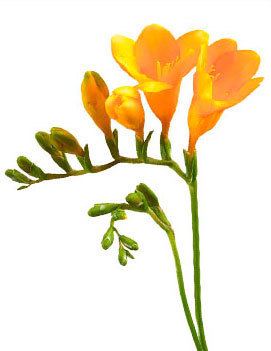Scientific name Freesia Rank Genus | Subfamily Ixioideae | |
 | ||
Lower classifications Freesia laxa, Freesia alba | ||
Freesia flowers how to grow and multiply
Freesia is a genus of herbaceous perennial flowering plants in the family Iridaceae, first described as a genus in 1866 by Chr. Fr. Echlon (1795-1868) and named after German botanist and doctor Friedrich Freese (1794-1878). It is native to the eastern side of southern Africa, from Kenya south to South Africa, most species being found in Cape Provinces. Species of the former genus Anomatheca are now included in Freesia. The plants commonly known as "freesias", with fragrant funnel-shaped flowers, are cultivated hybrids of a number of Freesia species. Some other species are also grown as ornamental plants.
Contents
- Freesia flowers how to grow and multiply
- How to plant freesias
- Description
- Systematics
- Cultivation and uses
- References

How to plant freesias
Description

They are herbaceous plants which grow from a conical corm 1–2.5 cm diameter, which sends up a tuft of narrow leaves 10–30 cm long, and a sparsely branched stem 10–40 cm tall bearing a few leaves and a loose one-sided spike of flowers with six tepals. Many species have fragrant narrowly funnel-shaped flowers, although those formerly placed in the genus Anomatheca, such as F. laxa, have flat flowers.
Freesias are used as food plants by the larvae of some Lepidoptera species including Large Yellow Underwing.
Systematics
The genus was named in honor of Friedrich Heinrich Theodor Freese (1795–1876), a German physician.

- Freesia andersoniae L.Bolus - the Cape Provinces, Free State
- Freesia caryophyllacea (Burm.f.) N.E.Br. (syn. F. elimensis L.Bolus, F. parva N.E.Br., F. xanthospila (DC.) Klatt) - Heuningrug region in the Cape Provinces
- Freesia corymbosa (Burm.f.) N.E.Br. (syn. F. armstrongii W.Watson, F. brevis N.E.Br.) - the Cape Provinces
- Freesia fergusoniae L.Bolus - the Cape Provinces
- Freesia fucata J.C.Manning & Goldblatt - Hoeks River Valley in the Cape Provinces
- Freesia grandiflora (Baker) Klatt - Zaire, Tanzania, Malawi, Mozambique, Zambia, Zimbabwe, Swaziland, northeastern South Africa
- Freesia laxa (Thunb.) Goldblatt & J.C.Manning (syn. F. cruenta (Lindl.) Klatt) - from Rwanda + Kenya south to the Cape Provinces; naturalized in Madeira, Mauritius, Réunion, Australia, Florida, Argentina
- Freesia leichtlinii Klatt (syn. F. middlemostii F.Barker, F. muirii N.E.Br.) - the Cape Provinces; naturalized in Corsica, California, Florida, Argentina
- Freesia marginata J.C.Manning & Goldblatt - the Cape Provinces
- Freesia occidentalis L.Bolus (syn. F. framesii L.Bolus) - the Cape Provinces
- Freesia praecox J.C.Manning & Goldblatt - the Cape Provinces
- Freesia refracta (Jacq.) Klatt (syn. F. hurlingii L.Bolus) - the Cape Provinces; naturalized in France, Canary Islands, Madeira, Bermuda, St. Helena
- Freesia sparrmanii (Thunb.) N.E.Br. - Langeberg in the Cape Provinces
- Freesia speciosa L.Bolus (syn. F. flava (E.Phillips & N.E.Br.) N.E.Br.) - the Cape Provinces
- Freesia verrucosa (B.Vogel) Goldblatt & J.C.Manning (syn. F. juncea (Pourr.) Klatt) - the Cape Provinces
- Freesia viridis (Aiton) Goldblatt & J.C.Manning - Namibia, the Cape Provinces
Species of the former genus Anomatheca are now included in Freesia:
Cultivation and uses

The plants usually called "freesias" are derived from crosses made in the 19th century between F. refracta and F. leichtlinii. Numerous cultivars have been bred from these species and the pink- and yellow-flowered forms of F. corymbosa. Modern tetraploid cultivars have flowers ranging from white to yellow, pink, red and blue-mauve. They are mostly cultivated professionally in the Netherlands by about 80 growers. Freesias can be readily increased from seed. Due to their specific and pleasing scent, they are often used in hand creams, shampoos, candles, etc., however, the flowers are mainly used in wedding bouquets.

They can be planted in the fall in USDA Hardiness Zones 9-10 (i.e. where the temperature does not fall below about −7 °C (20 °F)), and in the spring in Zones 4-8.
Freesia laxa (formerly called Lapeirousia laxa or Anomatheca cruenta) is one of the other species of the genus which is commonly cultivated. Smaller than the scented freesia cultivars, it has flat rather than cup-shaped flowers.
Extensive 'forcing' of this bulb occurs in Half Moon Bay in California where several growers chill the bulbs in proprietary methods to satisfy cold dormancy which results in formation of buds within a predicted number of weeks – often 5 weeks at 55 °F (13 °C).
